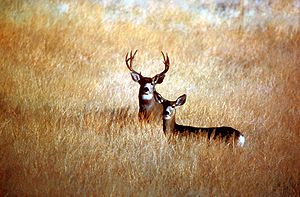 |

 |

No lucky numbers are required for this outstanding hunting opportunity
|
Now is the time to get your application in for Nebraska's Super Tag Lottery!
If drawn, you would join an elite group of hunters who have been granted
the unique opportunity for a combination permit, which features a bag limit of
The Super Tag permit is valid during 2013 and 2014, meaning you have two years worth of hunting seasons to fill it. You may hunt with any legal weapon in any open hunting unit during the general hunting season for each species.
The lottery is open to Nebraska residents only, and all 'once-in-a-lifetime' bull elk permit holders are eligible to participate.
Cost to enter the lottery is $25 (nonrefundable), and it can be entered online by clicking here. Just scroll down to the "Super Tag Lottery" section. (One entry per person.) The drawing for the Super Tag winner will be held on July 26, 2013.
Deer Permits on Sale July 8
All remaining deer permits go on sale Monday, July 8 at 1 p.m. (CST) to residents and nonresidents alike. Complete details are in the 2013 Big Game Guide.
Outdoor 4-H Camps Offer Buddy Discount
"Buddy discounts" are offered for our Outdoor Skills 4-H camps:
Visit our website to learn more about these camps. (Note: registrations must be mailed in together and not done online.) Questions? Contact Aaron Hershberger ataaron.hershberger@nebraska.gov
|


 |




 |

 |
| Door County (Photo credit: Wikipedia) |



North Dakota deer hunters are reminded the deadline for submitting applications for the 2013 gun season is June 5. Hunters are encouraged to apply online at the State Game and Fish Department website, gf.nd.gov.
The deadline applies to muzzleloader, regular gun, gratis and nonresident landowner, and youth antlered mule deer applications (specifically for antlered mule deer in units 3B1, 3B2, and 4A-4F).
Gratis applications received on or before the regular deer gun lottery application deadline (June 5) will be issued an any-legal-deer license. Gratis applications received after the deadline will be issued based on licenses remaining after the lottery –generally only antlerless licenses remain.
The deadline for regular statewide youth licenses is Sept. 1.
 |
